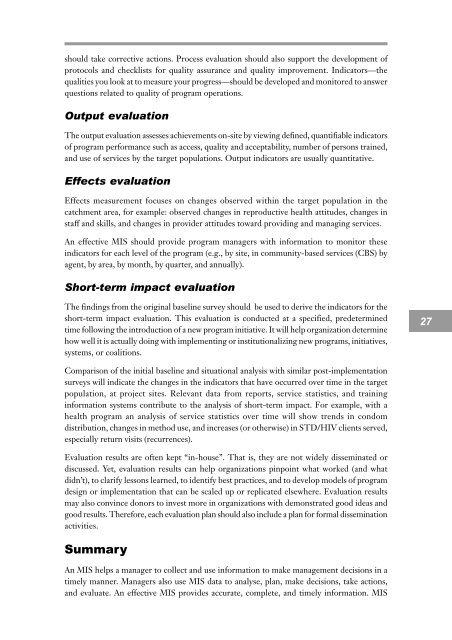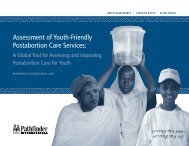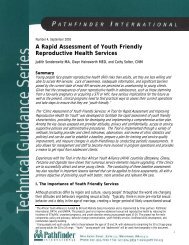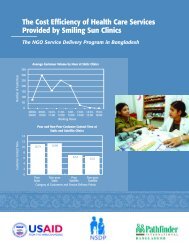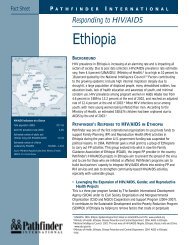Management Information Systems - Pathfinder International
Management Information Systems - Pathfinder International
Management Information Systems - Pathfinder International
You also want an ePaper? Increase the reach of your titles
YUMPU automatically turns print PDFs into web optimized ePapers that Google loves.
should take corrective actions. Process evaluation should also support the development ofprotocols and checklists for quality assurance and quality improvement. Indicators—thequalities you look at to measure your progress—should be developed and monitored to answerquestions related to quality of program operations.Output evaluationThe output evaluation assesses achievements on-site by viewing defined, quantifiable indicatorsof program performance such as access, quality and acceptability, number of persons trained,and use of services by the target populations. Output indicators are usually quantitative.Effects evaluationEffects measurement focuses on changes observed within the target population in thecatchment area, for example: observed changes in reproductive health attitudes, changes instaff and skills, and changes in provider attitudes toward providing and managing services.An effective MIS should provide program managers with information to monitor theseindicators for each level of the program (e.g., by site, in community-based services (CBS) byagent, by area, by month, by quarter, and annually).Short-term impact evaluationThe findings from the original baseline survey should be used to derive the indicators for theshort-term impact evaluation. This evaluation is conducted at a specified, predeterminedtime following the introduction of a new program initiative. It will help organization determinehow well it is actually doing with implementing or institutionalizing new programs, initiatives,systems, or coalitions.27Comparison of the initial baseline and situational analysis with similar post-implementationsurveys will indicate the changes in the indicators that have occurred over time in the targetpopulation, at project sites. Relevant data from reports, service statistics, and traininginformation systems contribute to the analysis of short-term impact. For example, with ahealth program an analysis of service statistics over time will show trends in condomdistribution, changes in method use, and increases (or otherwise) in STD/HIV clients served,especially return visits (recurrences).Evaluation results are often kept “in-house”. That is, they are not widely disseminated ordiscussed. Yet, evaluation results can help organizations pinpoint what worked (and whatdidn’t), to clarify lessons learned, to identify best practices, and to develop models of programdesign or implementation that can be scaled up or replicated elsewhere. Evaluation resultsmay also convince donors to invest more in organizations with demonstrated good ideas andgood results. Therefore, each evaluation plan should also include a plan for formal disseminationactivities.SummaryAn MIS helps a manager to collect and use information to make management decisions in atimely manner. Managers also use MIS data to analyse, plan, make decisions, take actions,and evaluate. An effective MIS provides accurate, complete, and timely information. MIS


